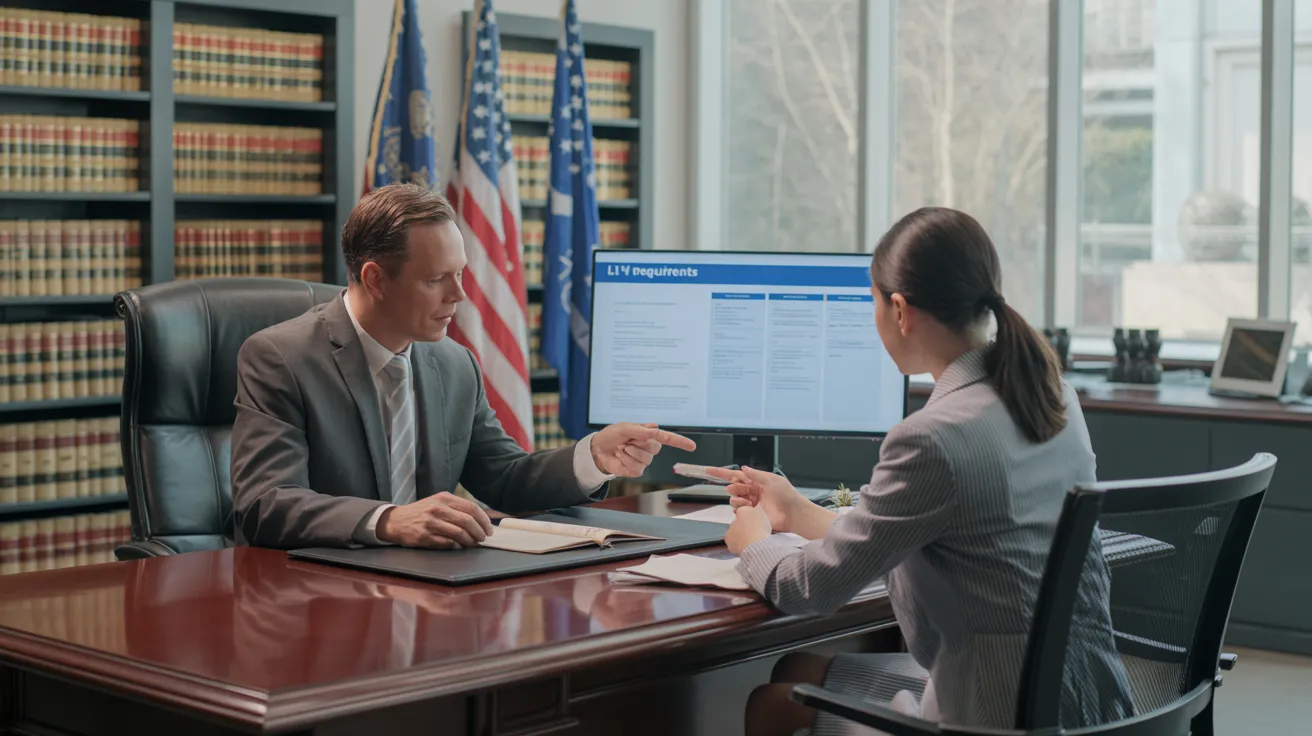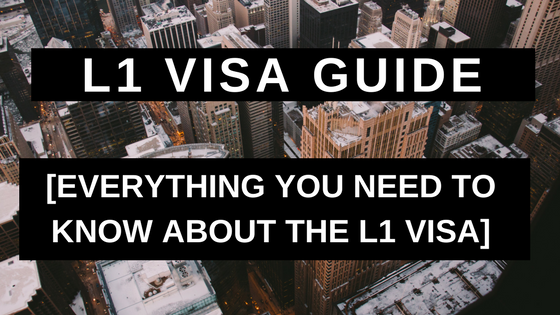Everything You Required to Know About the L1 Visa: Advantages, Demands, and Much more
The L1 Visa offers as an important tool for international business seeking to move workers to the United States, helping with both functional performance and the transfer of specialized knowledge. With distinct classifications for execs and specialized experts, this visa provides many benefits, including prospective paths to long-term residency. However, understanding the qualification requirements and application procedure is necessary for a successful shift. As we check out the ins and outs of the L1 Visa, it comes to be clear that maneuvering its complexities is vital for organizations aiming to take advantage of worldwide skill effectively. What challenges might you run into along the road?
Overview of the L1 Visa

Sorts Of L1 Visas

Several types of L1 visas cater to the varied requirements of multinational business looking to transfer employees to the United States. The two main groups of L1 visas are L1A and L1B, each created for certain duties and obligations within an organization. L1 Visa Requirements.The L1A visa is intended for supervisors and executives. This classification permits firms to move people who hold supervisory or executive settings, enabling them to look after procedures in the united state. This visa is legitimate for a preliminary duration of as much as 3 years, with the possibility of extensions for a total amount of as much as 7 years. The L1A visa is particularly helpful for firms seeking to develop a strong management presence in the U.S. market.On the various other hand, the L1B visa is marked for workers with specialized knowledge. This includes people who have sophisticated proficiency in details areas, such as proprietary technologies or distinct procedures within the firm. The L1B visa is also legitimate for an initial three-year period, with extensions readily available for up to 5 years. This visa category is excellent for companies that need workers with specialized abilities to boost their procedures and maintain an one-upmanship in the U.S.Both L1A and L1B visas permit double intent, indicating that visa holders can make an application for permanent residency while on the visa. Comprehending the differences in between these two groups is important for companies intending to browse the complexities of employee transfers to the United States efficiently
Qualification Requirements
To get approved for an L1 visa, both the employer and the employee should satisfy certain eligibility criteria set by U.S. migration authorities. The L1 visa is designed for intra-company transferees, enabling multinational firms to transfer workers to their U.S. offices.First, the employer has to be a qualifying organization, which implies it has to have a parent company, branch, subsidiary, or associate that is operating both in the U.S. and in the foreign country. This partnership is crucial for demonstrating that the staff member is being transferred within the exact same company framework. The employer should additionally have actually been doing company for a minimum of one year in both locations.Second, the staff member must have been utilized by the international business for at the very least one constant year within the 3 years coming before the application. This work should be in a managerial, executive, or specialized knowledge capacity. For L1A visas, which accommodate managers and executives, the staff member must demonstrate that they will remain to operate in a comparable capacity in the united state For L1B visas, meant for workers with specialized expertise, the specific should possess unique experience that contributes considerably to the company's procedures.
Application Process
Navigating the application process for an L1 visa entails a number of vital steps that have to be completed accurately to ensure L1 Visa a successful outcome. The initial step is to determine the ideal category of the L1 visa: L1A for managers and execs, or L1B for employees with specialized understanding. This distinction is substantial, as it influences the paperwork required.Once the classification is determined, the united state employer must submit Kind I-129, Request for a Nonimmigrant Employee. This kind must include in-depth details regarding the company, the staff member's duty, and the nature of the job to be carried out in the U.S. Accompanying paperwork commonly includes evidence of the relationship in between the U.S. and foreign entities, proof of the worker's credentials, and info pertaining to the job offer.After submission, the U.S. Citizenship and Immigration Services (USCIS) will assess the request. If authorized, the employee will be notified, and they can after that look for the visa at a united state consular office or embassy in their home country. This entails finishing Kind DS-160, the Online Nonimmigrant copyright, and setting up an interview.During the interview, the candidate must present various documents, consisting of the authorized Kind I-129, evidence of work, and any extra sustaining evidence. Following the meeting, if the visa is given, the employee will get a visa stamp in their key, enabling them to enter the united state to benefit the sponsoring company. Correct preparation and comprehensive documents are key to steering this process properly.
Advantages of the L1 Visa
Among the noteworthy benefits of the L1 visa is its capacity to facilitate the transfer of essential workers from worldwide workplaces to the USA. This visa is especially beneficial for international companies seeking to maintain uniformity in operations and leadership throughout borders. By enabling execs, managers, and specialized workers to function in the U.S., organizations can ensure that their most essential talent is offered to drive organization objectives.Another considerable benefit of the L1 visa is its fairly straightforward application procedure compared to other job visas. Organizations can petition for the L1 visa without the requirement for a labor qualification, which streamlines the employment of international workers. Additionally, the visa can be provided for an initial duration of as much as 3 years, with the possibility of extensions, helping with lasting assignments.The L1 visa additionally offers a course to irreversible residency. Employees on L1A visas (for supervisors and execs) can get an Environment-friendly Card after one year, quickening their adjustment to long-term status. This function is an eye-catching motivation for gifted people searching for stability in the united state workforce.Additionally, L1 visa holders can bring their instant relative to the U.S. under L2 condition, enabling partners and children to stay and study in the country, enhancing the total charm of this visa category. Generally, the L1 visa acts as an essential device for global organizations, cultivating cross-border partnership and skill mobility.
Common Difficulties
While the L1 visa uses various benefits for international firms and their workers, it is not without its challenges. One notable difficulty is the rigid paperwork and qualification demands enforced by the U.S. Citizenship and Migration Solutions (USCIS) Business have to offer in-depth evidence of the foreign worker's qualifications, the nature of business, and the qualifying relationship between the U.S. and international entities. This procedure can be time-consuming and may need lawful competence to navigate successfully.Another difficulty is the potential for scrutiny during the request process. USCIS officers may question the authenticity of the service procedures or the worker's role within the organization. This scrutiny can cause hold-ups or perhaps denials of the copyright, which can substantially affect the firm's operational strategies and the worker's job trajectory.Furthermore, the L1 visa is linked to the sponsoring employer, which indicates that job changes can complicate the visa status. If an L1 visa holder wishes to switch over companies, they must usually seek a different visa category, which can add complexity to their migration journey.Lastly, keeping compliance with L1 visa guidelines is important. Employers must ensure that their staff member's function lines up with the first petition and that the organization remains to meet the qualification needs. Failing to do so can cause retraction of the visa, influencing both the staff member and the organization. These obstacles demand comprehensive preparation and continuous management to ensure an effective L1 visa experience.
Tips for Success
To effectively navigate the L1 visa process, careful preparation is crucial. Begin by extensively understanding the particular requirements for the L1 visa category you are making an application for, whether L1A for managers and execs or L1B for employees with specialized understanding. Collect all essential documents early while doing so, including proof of your employment history, business structure, and the nature of business operations.Engage legal guidance experienced in migration legislation to assist you with the intricacies of the application. An attorney can help ensure that your application is total, precise, and compelling. They can likewise assist in preparing for potential ask for proof (RFEs) by proactively attending to areas that might elevate questions.Additionally, preserve clear communication with your company, who need to supply crucial support for your application. L1 Visa Qualifications. Confirm that they comprehend their responsibilities, including filing the essential petitions and offering documents that confirms your duty in the organization.Prepare for the visa meeting by exercising response to common questions regarding your expert background and the nature of your employment. Demonstrating self-confidence and clarity can considerably influence the end result of your application
Regularly Asked Inquiries
Can Family Members Accompany L1 Visa Owners?
Yes, relative can accompany L1 visa holders. Spouses and unmarried children under 21 years of ages are qualified for L2 visas, which permit them to live and examine in the USA throughout the L1 owner's keep.
For How Long Can L1 Visa Owners Stay in the united state?
L1 visa owners can at first stay in the U.S. for approximately 3 years (L1 Visa Requirements). This period may be prolonged, allowing an optimum remain of 7 years for L1A visa owners and five years for L1B visa owners
Is the L1 Visa a Double Intent Visa?

Can L1 Visa Holders Request a Permit?
Yes, L1 visa holders can obtain a copyright - L1 Visa. The L1 visa sustains dual intent, allowing owners to seek long-term residency while maintaining their non-immigrant status, facilitating a smoother changeover to an environment-friendly card
What Happens if an L1 copyright Is Denied?
If an L1 copyright is refuted, the candidate might get a notice outlining the reasons for denial. L1 Visa. They can appeal the choice, reapply, or check out alternative visa options depending upon their circumstances and certifications
Final thought
In recap, the L1 Visa acts as a necessary instrument for multinational business looking for to move employees to the USA. Understanding the differences in between L1A and L1B classifications, along with the eligibility needs and application processes, is crucial for effective navigating of this non-immigrant classification. The benefits offered, including streamlined applications and pathways to permanent residency, even more improve its charm. Resolving usual challenges properly can bring about a much more positive result in the copyright procedure.
Comments on “L1 Visa Info”